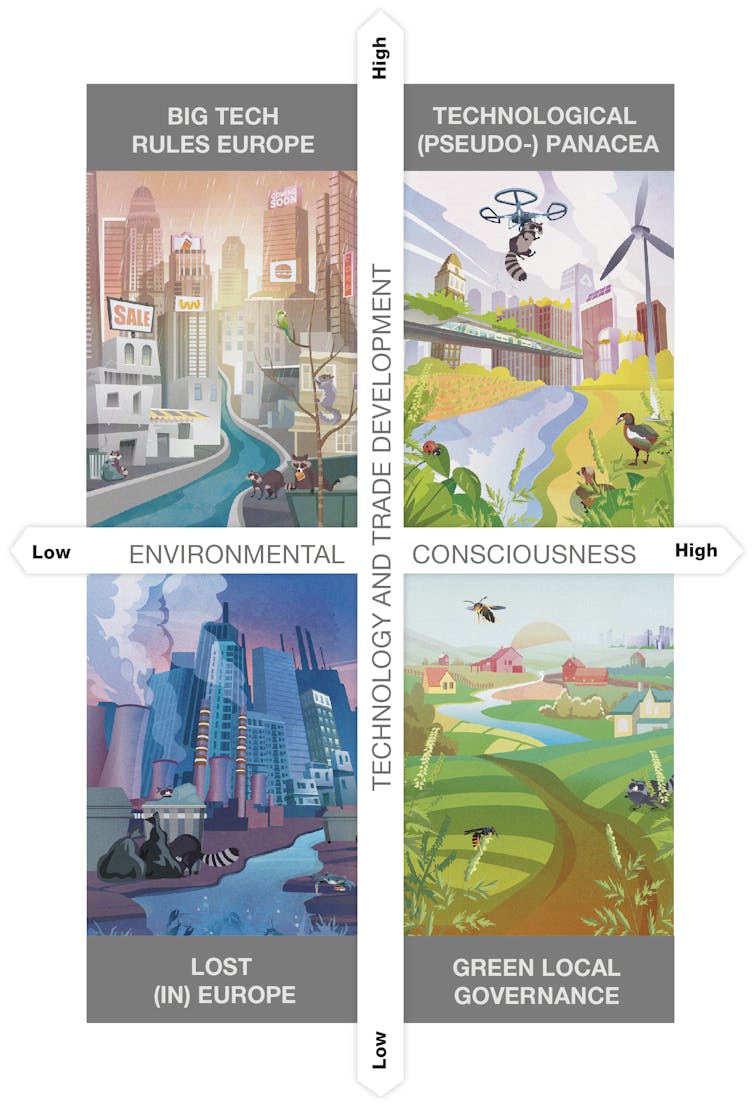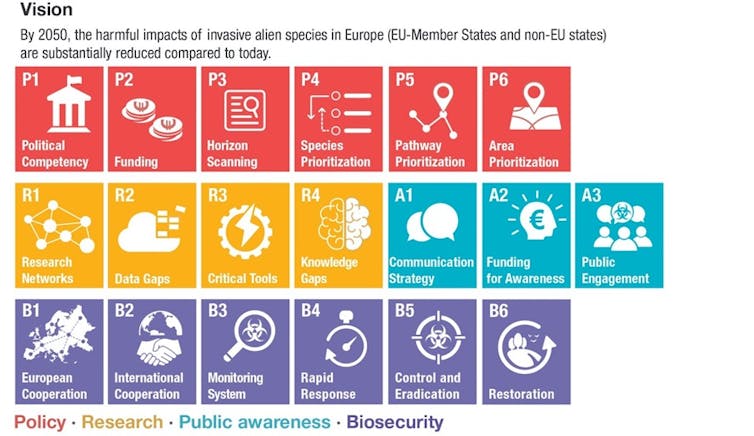Biological invasions are the main cause of biodiversity loss, but they can also have serious social and economic repercussions. In Europe, over 13,000 non-native (or “alien”) species have an established presence, around 1,500 of which are invasive species that have a negative impact on their surroundings. Species of particular concern are the brown rat, raccoon, red swamp crayfish, tiger mosquito, varroa mite, ragweed, and tree of heaven, among many others.
Various studies have predicted that, by 2050, the number of non-native species in Europe will grow by as much as 64%. This estimate assumes that current trends will continue unchanged. However, the number and repercussions of invasive species depend on a range of environmental and socioeconomic factors that will evolve in ways that are hard to predict.
IVAN VIEITO GARCIA/Shutterstock
Four possible future scenarios
Researchers, managers and policymakers from various countries have developed four qualitative scenarios on the future of biological invasions up to 2050. This was done as part of the AlienScenarios and InvasiBES projects, which were funded by the 2017-2018 Belmont Forum and BiodivERsA joint call for research proposals.
The scenarios are not predictions as such – they are narrative descriptions and accounts of what could happen in the future under a range of different circumstances.
In particular, our scenarios take into account the socio-ecological developments that are critical for invasive species, and they are more biodiversity-focused than other global change scenarios, such as the shared socioeconomic pathways (SSPs) used by many climate change reports. The scenarios are as follows:
-
Big Tech Rules Europe: Distrust in governments leads to companies having increased power, while populations concentrate in cities and suffer economic hardship. An increase in invasive species and a reduction in their coordinated management.
-
Technological (Pseudo-)Panacea: Rapid technological development, large trade volumes and high biosecurity. European societies concentrate in ‘smart cities’. The rate of invasive species spreading and becoming established is low due to solid, strict biosecurity measures.
-
Green Local Governance: Local governments acquire more influence. By adopting degrowth, society begins to value locally produced goods, and spreads from urban centres to rural areas. Reduced trade limits the spread of invasive species, but inefficient coordination is an obstacle to management and biosecurity.
Read more:
Green growth or degrowth: what is the right way to tackle climate change?
- Lost (in) Europe: Reduced international cooperation and increased social inequality. Pollution, climate change and biodiversity loss get worse. There are fewer invasive species due to reduced trade, but they are barely controlled or managed.

Kris Tsenova (Paidia Consulting Ltd.), CC BY-SA
Going beyond direct management
We have used these scenarios to develop a strategy for the management of biological invasions.
The strategy was built around the vision that “by 2050, the harmful impacts of invasive species in Europe (EU member states and non-EU states) are substantially reduced compared to today”, and that we can adapt to the uncertainties arising from the scenarios mentioned above.
This management strategy covers 19 different objectives, grouped into four categories:
-
Political: improving political competence on the issue, increasing funding, scanning the horizon for future alien species, prioritisation of invasive species, invaded areas and pathways for management.
-
Research: establishing research networks, detecting gaps in data and knowledge regarding invasive species, and developing critical tools to record and control their spread.
-
Public awareness: setting up communication strategies, funding to raise awareness, and enhancing public engagement.
-
Biosecurity: an increase in international and European cooperation, creating a monitoring system and developing systems for rapid response, control, erradication and restoration.

This range of goals highlights the complexity of managing invasive species, and the need to consider actions beyond direct management, such as prevention, eradication and control.
Several of these objectives have been identified by other studies, but the AlienScenarios and InvasiBES projects expand on them, integrating existing knowledge into a comprehensive framework. This framework will guide actions on invasive species in different future scenarios, and help to design a long-term management strategy for biological invasions in Europe.
Main recommendations
Based on the relationship between our goals and the main elements of the management strategy, we have four main recommendations for managing invasive species in Europe:
-
Establish a dedicated European agency, or an intergovernmental agreement, that has the mandate and resources to regulate and oversee activities related to the management of invasive species.
-
Establish a cross-sectoral communication strategy on invasive species (including a dedicated curriculum for schools) and a centralised, multilingual communication platform at the European level.
-
Adopt standard protocols to gather and provide access to data on invasive species, with the aim of guiding management decisions.
-
Set up a monitoring system to assess biological invasions on a European and national level.
None of these recommendations will be sufficient on their own, but they are the pillars of a long-term strategy for managing biological invasions at the European level. It is time to shift the focus towards a more holistic perspective, one that accounts for the unique situations of different sectors and countries, and that explicitly considers plausible future scenarios.



